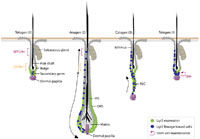New drugs could stop the growth of drug-resistant childhood tumors
Current drugs may stop working against the most common type of brain tumor in children, Medulloblastoma, but the tumor could be targeted in a new way, according to Stanford University scientists.
In research a team led by Prof. Matthew P. Scott at the University's School of Medicine tested a drug called Roflumilast in mice with a brain tumor that is resistant to Vismodegib, the drug in current use. Roflumilast is normally used to treat inflammatory lung diseases. It dramatically inhibited tumor growth from the first day of treatment. As expected, Vismodegib had no effect.
Roflumilast is already FDA-approved so it is readily available for patients. However, it also causes side effects, so further studies are needed to find ways to reduce them or to develop other drugs that avoid this problem.
"New drugs beyond Vismodegib are needed because the current treatments for medulloblastoma have severe side effects, cure only about two-thirds of patients, and leave treated patients with lasting damage," says Dr. Xuecai Ge, the first author of the study.
Some birth defects and tumors are caused by abnormalities in the way cells communicate with one another as an embryo grows. The Hedgehog signalling pathway is a cell-to-cell communication system essential for the normal growth of many tissues and organs in animal embryos.
Among other roles, Hedgehog signalling proteins stimulate the proliferation of certain type of precursor cells before they mature into neurons in the developing cerebellum - the lower rear part of the brain. When genes that encode components of the Hedgehog signalling system are damaged by mutation, cells may think they are receiving a growth-stimulating signal when they are not. This leads to loss of growth control, and contributes to a wide range of tumors, including medulloblastoma, the most common malignant brain tumor in children.
The most common human cancer, basal cell carcinoma of the skin, is also due to loss of control of Hedgehog signalling and is treatable with Vismodegib. However those tumors, like the brain tumors, can mutate further to become resistant to the drug.
Within medulloblastomas, the cancer cells mutate continuously, so even cancers that can initially be treated with Vismodegib will selectively lose sensitive cells while mutated resistant cells eventually proliferate and take over. Vismodegib targets a particular molecule in the Hedgehog signalling pathway, inhibiting cell division. In the current study, the scientists uncover an important new way in which the response to a Hedgehog signal is regulated. This could provide a new target for treatment.
They found that a protein called Semaphorin 3 enhances the response to a Hedgehog signal. Elevated levels of Semaphorin 3 have been found in medulloblastoma. They reasoned that blocking the effect of Semaphorin 3 could inhibit the response to Hedgehog and therefore cell division.
Semaphorin 3 activates an enzyme called PDE4D. By inhibiting PDE4D with a drug, Roflumilast, the scientists were able to inhibit tumor growth that had arisen from loss of control of Hedgehog signalling. Since Roflumilast affects a process that is independent of the one affected by Vismodegib, it works against Vismodegib-resistant tumors.
Roflumilast is already used to treat chronic obstructive pulmonary disease. It and other PDE4D inhibitors are also in clinical trials to improve cognitive and psychological disorders including memory loss. However, they have severe side effects, such as depression and weight loss.
"Our study shows that it is a priority to repurpose PDE4D inhibitors, perhaps in combination with other medicines, as a promising therapy for devastating and potentially fatal childhood brain tumors," says Dr. Ge.
PDE4D inhibitors could also be effective against more common cancers such as basal cell carcinoma that also arise from damage to Hedgehog signalling.





















































